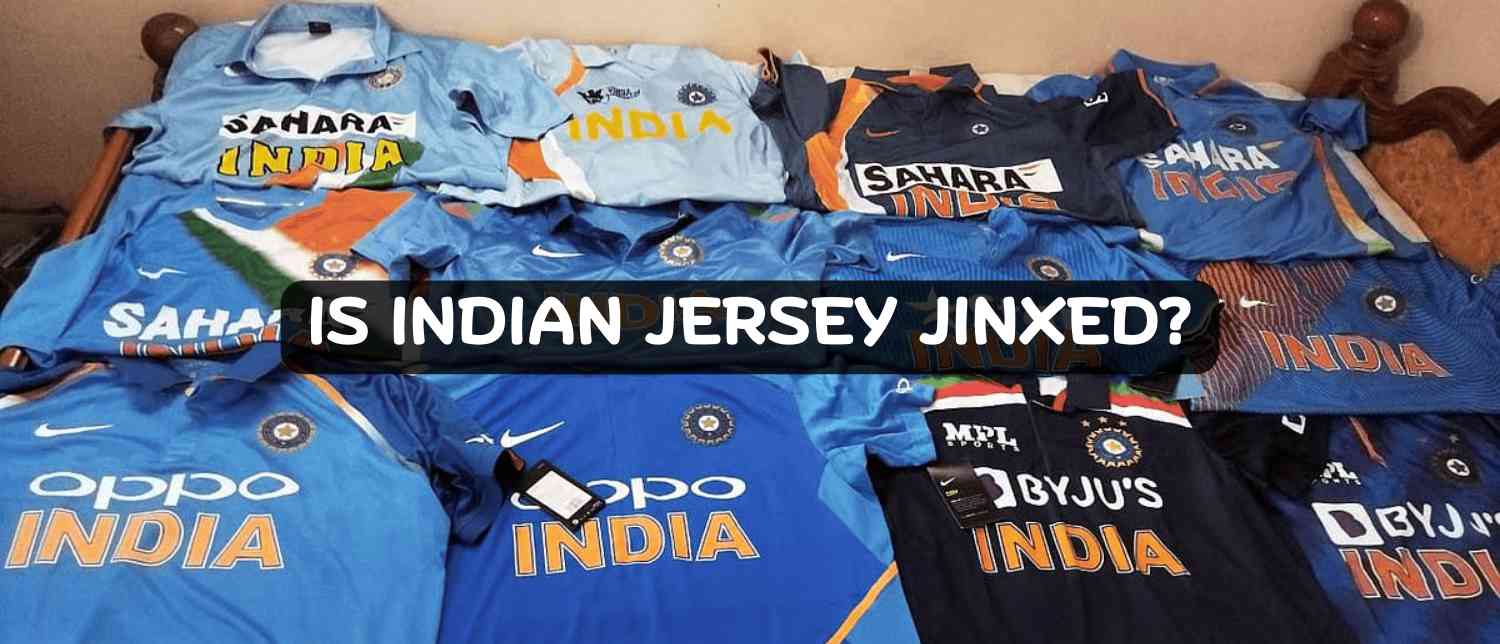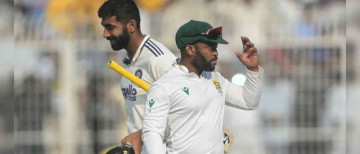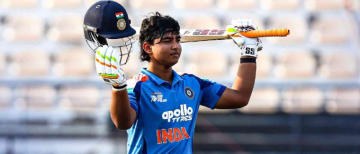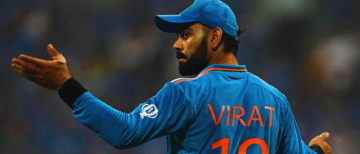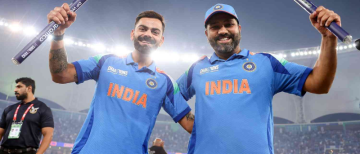Few marketing assets in India command the visibility of the national cricket team’s jersey. Adorning the chests of Virat Kohli, Rohit Sharma, and generations before them, the sponsor’s logo is seen by 700 million-plus viewers across more than 100 days of cricket annually. For a brand, this is the holy grail of advertising—a chance to etch itself into the cultural imagination of a cricket-obsessed nation.
Yet, behind the glamour lies a strange, almost eerie pattern. Over the past two decades, nearly every brand that has dared to put its name on the jersey has later found itself in deep financial, regulatory, or reputational trouble. Sahara, Star, Oppo, Byju’s, Paytm, Micromax, and most recently Dream11—all have stumbled.
So, is the Indian cricket jersey cursed, or are ambitious brands simply gambling too much for too little?
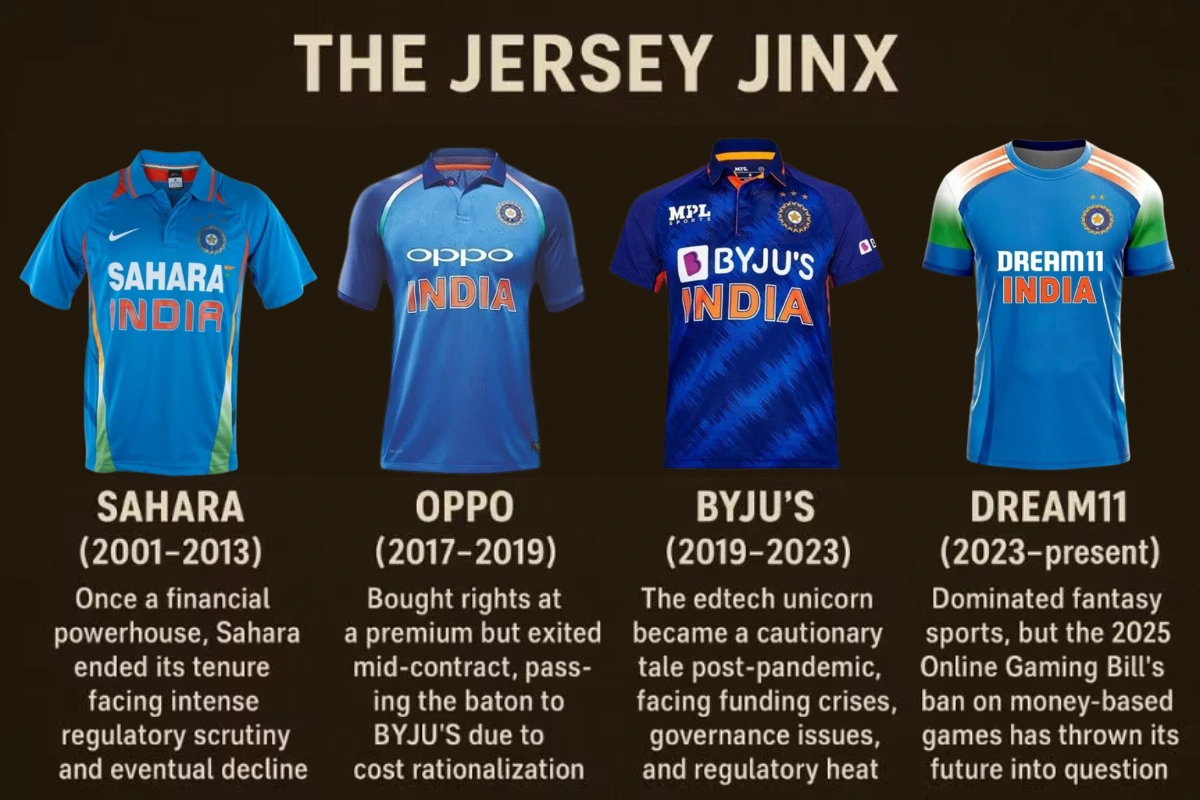
Sahara to Dream11: A Sponsorship Graveyard
- Sahara India (2001–2013): A Long Partnership Ends in Ruin
Sahara India was the most enduring sponsor of the Indian team, staying for 12 years. Its logo became synonymous with the Men in Blue during some of the team’s greatest moments—including the 2003 World Cup final and the 2011 World Cup victory.
But Sahara’s empire later collapsed under Securities and Exchange Board of India (SEBI) scrutiny. Reports suggest the company had raised nearly ₹24,000 crore from 30 million investors through dubious schemes. Founder Subrata Roy was arrested in 2014, and even after his death in 2023, recovery proceedings for investors’ money continue.
The once-proud sponsor’s downfall cemented the first chapter of the so-called “jersey jinx.”
- Star India (2014–2017): From Glitz to Regulatory Scrutiny
After Sahara, Walt Disney-owned Star India took over sponsorship. It was already a broadcasting giant, with Hotstar dominating cricket streaming. But even Star couldn’t escape trouble.
It was accused of abusing market dominance, leading to a Competition Commission of India probe. Meanwhile, mounting losses at Hotstar eventually forced a merger with Jio, weakening its once-formidable hold over Indian sports broadcasting.
- Micromax and Paytm (2014–2019): Homegrown Brands Stumble
Micromax Informatics briefly entered the frame in 2014–15, reportedly paying ₹18.01 crore for a season. Its sponsorship was short-lived, collapsing as Chinese handset makers like Xiaomi and Oppo bulldozed its market share.
Then came Paytm, which secured sponsorship rights for domestic and international tournaments between 2015–2019 for ₹203 crore, later renewing with a record ₹326 crore deal. While Paytm managed to stay longer than many others, it too struggled with mounting losses, regulatory pressure, and a turbulent IPO that left its stock battered.
- Oppo (2017–2019): Record Deal, Poor Returns
Chinese smartphone giant Oppo signed a record five-year deal worth ₹1,079 crore, paying ₹4.61 crore per bilateral game. However, it pulled out midway, citing unsustainable costs and poor return on investment. To make matters worse, Oppo faced patent battles with Nokia and InterDigital, adding to its financial woes.
- Byju’s (2019–2023): The Unicorn That Unraveled
Edtech giant Byju’s inherited Oppo’s contract in 2019 and paid a 5% reassignment fee. Initially hailed as a perfect fit, Byju’s sponsorship soon became another cautionary tale.
The company struggled after the pandemic boom ended. Funding dried up, governance lapses emerged, and regulatory scrutiny intensified. By 2023, the BCCI dragged Byju’s to the National Company Law Tribunal (NCLT) over a ₹158 crore default. Insolvency petitions piled up, and Byju’s later escalated the case to the NCLAT. The sponsorship that was meant to solidify Byju’s dominance instead highlighted its fragility.
- Dream11 (2023–2025): Gaming Giant Meets Regulatory Roadblock
Fantasy sports leader Dream11 signed a three-year, ₹358 crore deal in 2023. It was India’s biggest spender in sports advertising, allocating nearly ₹2,964 crore towards promotions in FY23.
But in August 2025, Parliament passed the Promotion and Regulation of Online Gaming Bill, 2025, banning money-based online gaming and related advertising. Overnight, Dream11’s sponsorship became untenable. Adding fuel to the fire, tax authorities accused the company of ₹1,200 crore GST evasion, with probes ongoing.
BCCI secretary Devajit Saikia confirmed that the board will no longer partner with money-based gaming companies in the future—a major policy shift.
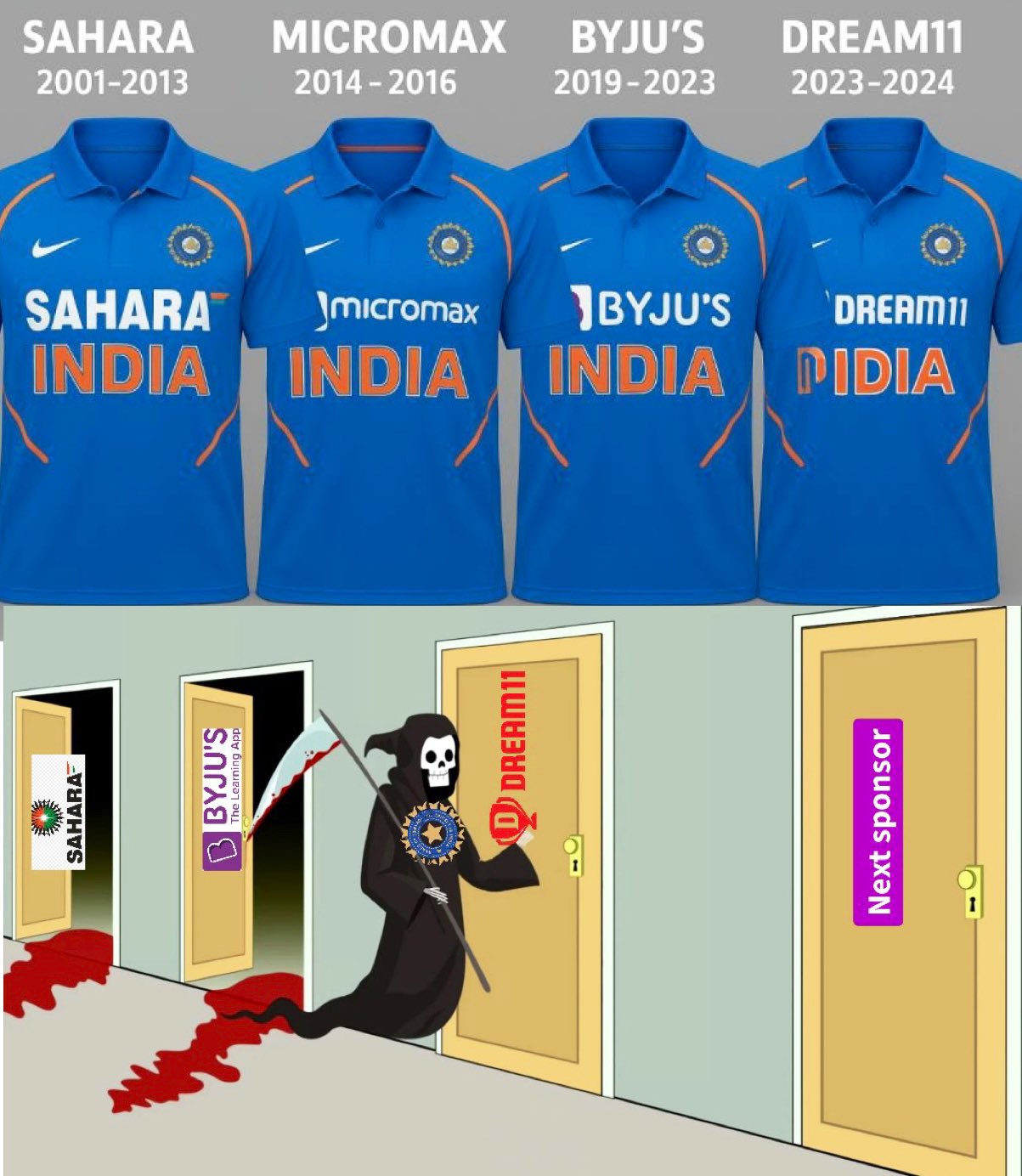
Expert Voices: Curse, Context, or Costly Gamble?
- The Jinx Believers
Brand consultant Harish Bijoor believes the pattern is too striking to ignore. “The Indian cricket jersey seems to be a jersey with a jinx for sure. We have had issues across each of the primary sponsors, whether it be Sahara, Byju’s, or Dream11,” he says.
To him, the curse stems not from superstition but from fragile sectors chasing instant fame. “Brands with money wanting immediate visibility find the cricket jersey the best thing to buy. But many of these sponsors are ill-prepared for the intense spotlight.”
- The Skeptics
Not everyone buys the jinx narrative. Arjun Singh Chauhan of Apollo 24/7 calls it “timing, not curse.” He argues that sponsors from volatile sectors like edtech and gaming coincidentally hit turbulence during their cricket sponsorships.
He points out that long-term legacy sponsors—Pepsi, Wills, and Tata—have thrived. According to Chauhan, the problem lies in new-age firms chasing “growth at any cost” without the financial muscle to sustain five-year commitments.
- The Global Perspective
Industry experts note that such “cursed sponsorships” aren’t unique to India. Across the globe, sports jersey sponsors have faltered:
-
BenQ went bankrupt after sponsoring Real Madrid.
-
XL Leisure folded while partnering West Ham.
-
Wish’s valuation collapsed after its LA Lakers deal.
-
Enron Field and PSINet Stadium both vanished after corporate scandals.
As Adityan Kayalakal of Jupiter Money says, “The jersey is a shortcut to fame, but as history shows, it’s also an unforgiving spotlight.”
Why Brands Still Line Up: The Blue Billion Dream
Despite the risks, sponsorship remains irresistible. The costs are staggering—₹50–130 crore annually for Team India’s jersey rights—but the reach is unparalleled: 700M+ viewers, 100+ days of cricket, pan-India impact.
For companies seeking category creation—fintech, EVs, telecom with 5G, or e-commerce giants like Amazon and Flipkart—the jersey offers unmatched visibility. As Bijoor puts it, “The cricket jersey is a great thing for an e-commerce player. I don’t see why Amazon or Flipkart shouldn’t be on it.”
The Future of Indian Jersey Sponsorship
With Dream11’s exit, the BCCI is preparing fresh tenders. Insiders suggest the next sponsor will likely come from stable, regulation-proof sectors like banking, insurance, automobiles, EVs, or telecom.
Legacy players with deep pockets and long-term ambitions are best placed to weather the storm. Tata’s IPL sponsorship is cited as a benchmark for sustained impact. The message is clear: the jersey rewards staying power, not quick wins.
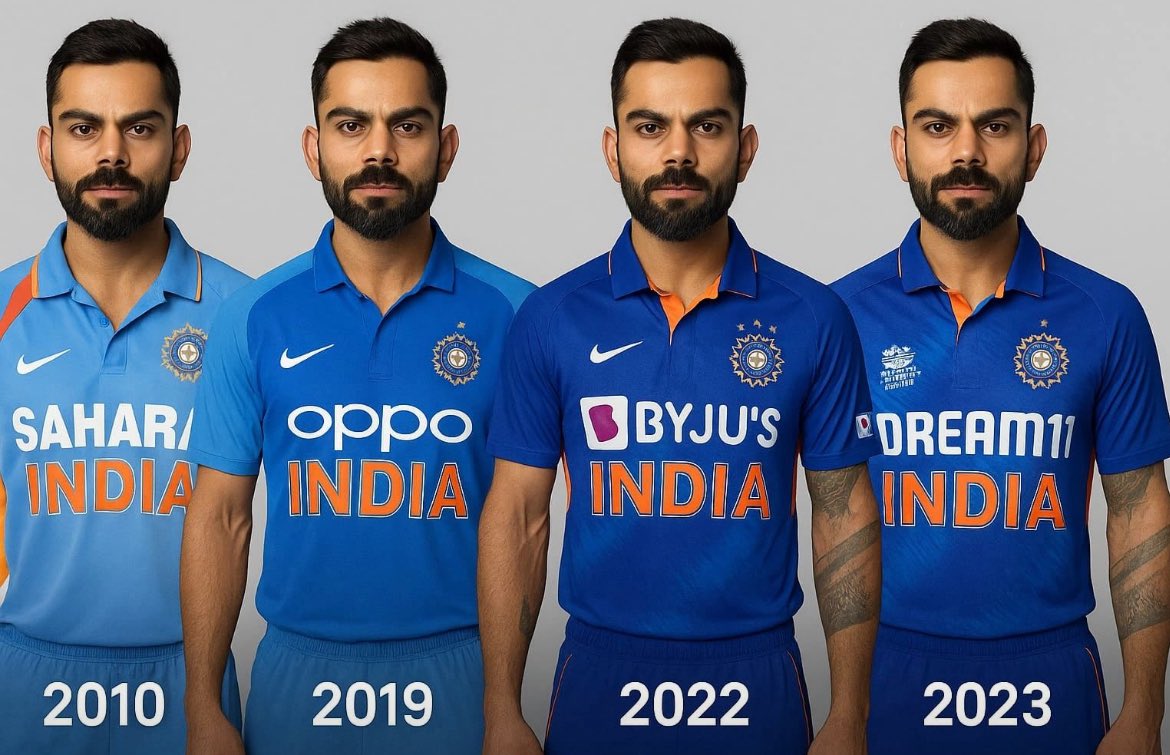
Curse or Harsh Business Lesson?
Business tycoon Harsh Goenka summed it up best with his viral quip: “Want to test your brand’s survival skills? Forget the stock market. Try sponsoring the Indian cricket team jersey!”
Whether you call it the “jersey jinx” or a high-risk marketing gamble, the truth lies in history. For fragile, fast-growth firms, the jersey often becomes a trap—exposing weaknesses under the harshest spotlight. But for resilient legacy players, it remains the most powerful branding stage in Indian sports.
The jersey isn’t cursed—it’s just unforgiving.
With inputs from agencies
Image Source: Multiple agencies
© Copyright 2025. All Rights Reserved. Powered by Vygr Media.

